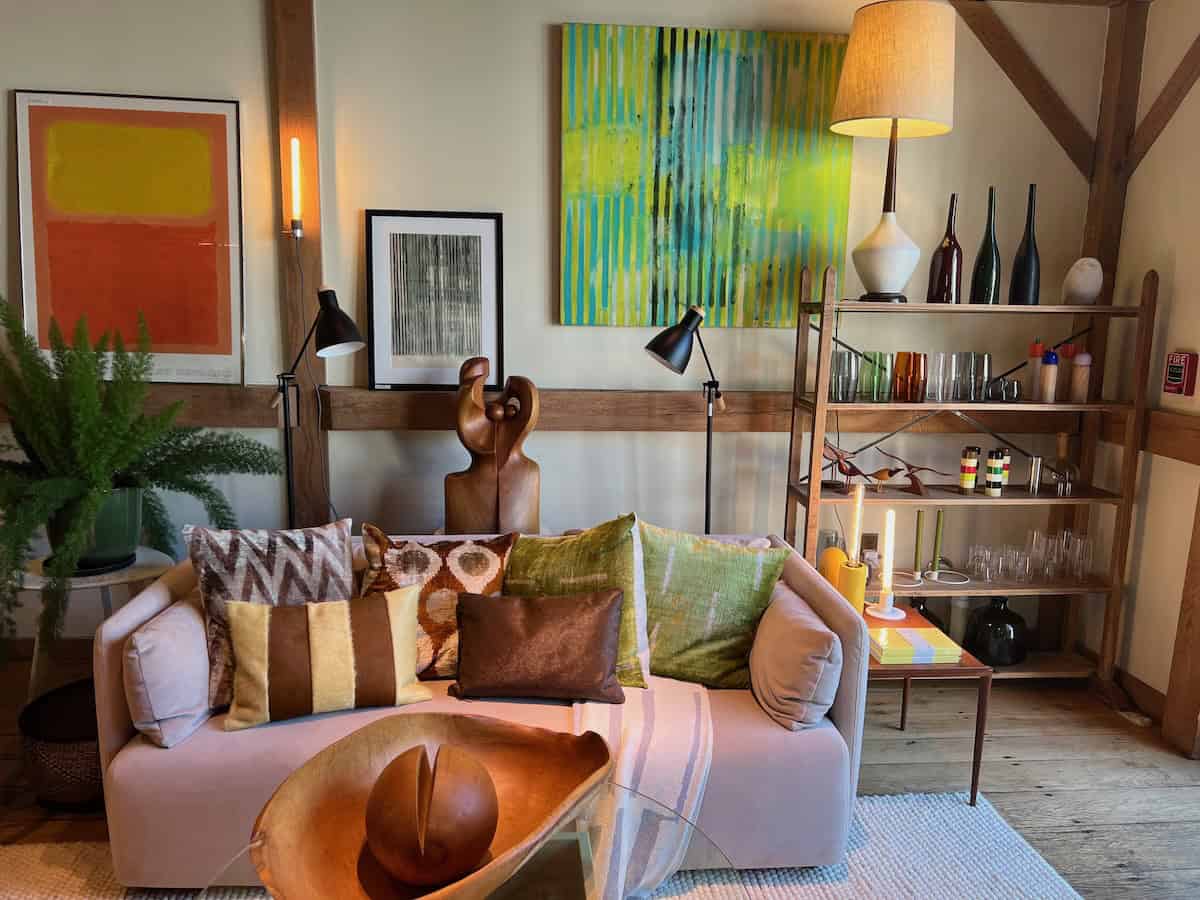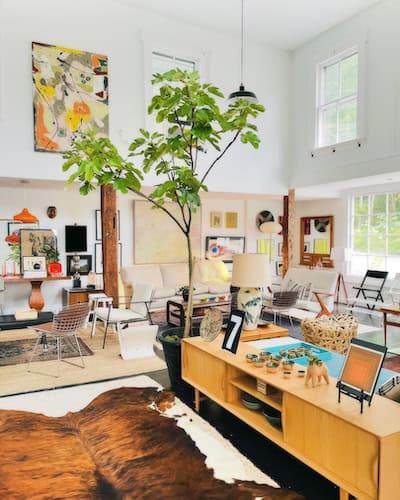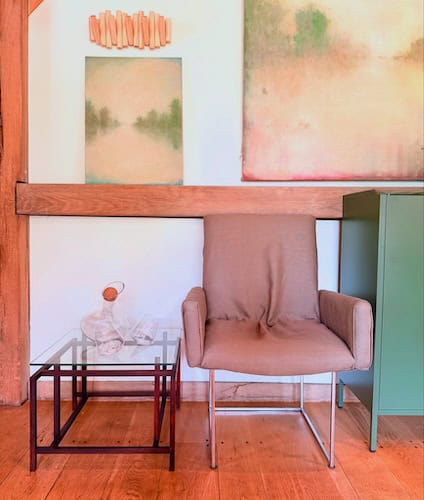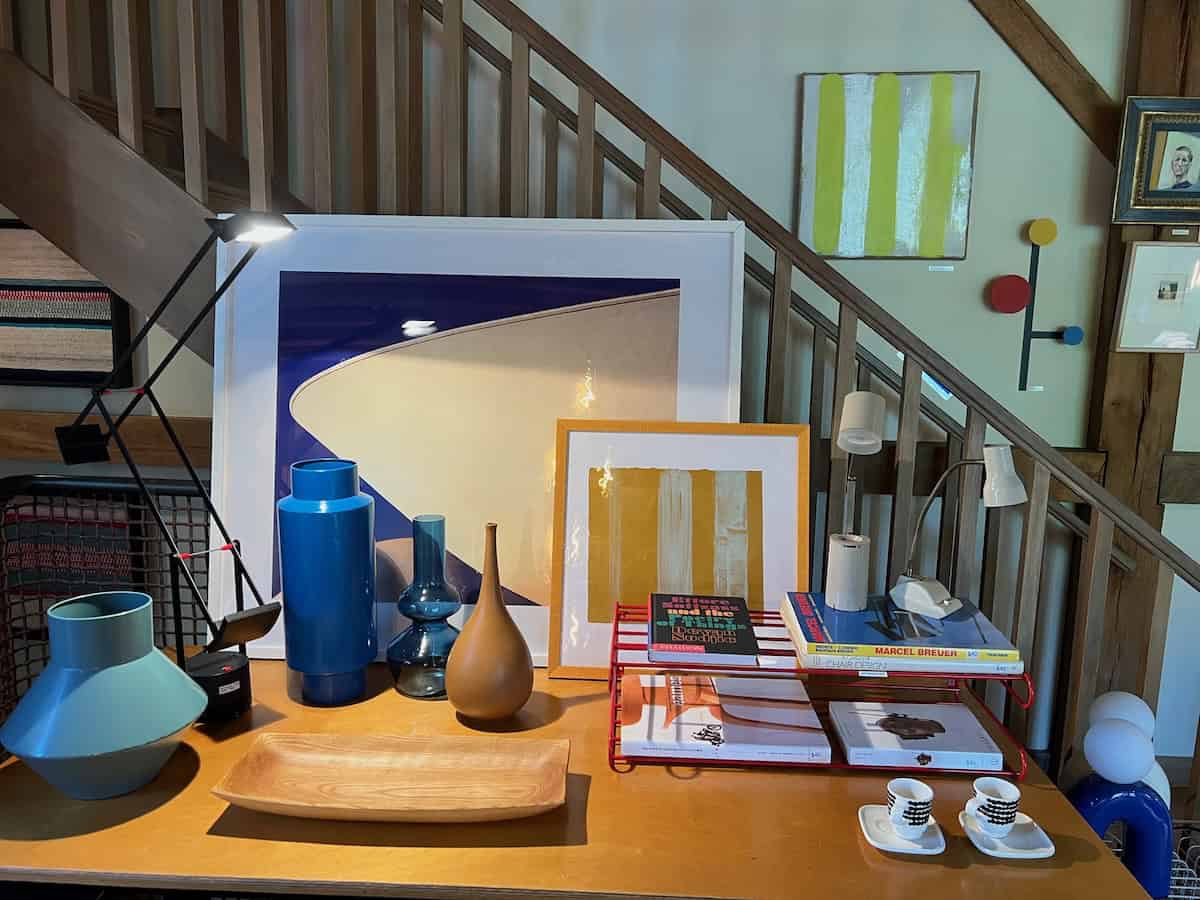Main Street Business

Mix Masters: Liz Macaire and Simon Kristoph of Macaire + Kristoph, West Cornwall and Kent, CT
I recently had the pleasure of sitting down with Liz Macaire and Simon Kristoph to discuss their business, Macaire + Kristoph, based in West Cornwall and Kent, CT.
Could you describe your business?
Liz: Our business is multi-dimensional, and we manage quite a few moving parts: two retail stores, interior design, staging, estate sales, and an art business. Our mothership store and design studio is a sprawling space in West Cornwall, CT, and we just opened a satellite location at Kent Barns, which we adore. The stores all sell curated vintage objects, furniture, lighting, and art. We deal with design and art history, which is something we are both obsessed with.
Our stores are open Thursday to Sunday, and we spend the rest of the week hunting down unique pieces, staging properties for sale, and working with our interior design clients. The espresso machine is on at all times!
How did two designers get together as business partners?
Liz: I have a long history working in the interior design industry in New York City and then started estate sales and interior design assignments in Litchfield County. The new business grew quickly so I needed a partner. I was fortunate enough to be introduced to Simon through a mutual friend. It was immediately a successful match. Simon brings a fresh and whimsical edge to the scene, always introducing color and modernism to the traditional.
Simon: My background was primarily in fashion; I started out in Japan, moved to the US to write, and ended up in design and merchandising. I was ready to move away from the rag trade and was hum drumming along doing small interior projects when I was introduced to Liz. We just hit the ground running, and that’s what I love about her. She’s all action, so it has been super fun from day one. Liz brings the romance to projects. We have similar taste but are also different in complementary ways. Liz has really changed my perception of having a business partner. She’s the kindest hustler I’ve ever met and has a design eye like no other.
Do you have a specific style?
Simon: We both appreciate authenticity and uniqueness. I have extensive mid-century to postmodern expertise, and Liz knows everything about textiles and the antiques world. So that’s where the collision happens. We tend to avoid mass-market pieces and replicas and instead look for craftsmanship and historical importance. Our mantra is “mix it up,” so I’d say that’s our style. It’s all about the juxtaposition.
Liz: Yes, agreed, and we love to accessorize with texture, color, or architecturally inspired items that pull everything together. It can be a monumental effort, or not. The end product is worth it either way.
Who are your design icons?
Simon: Salvador Dali and Rei Kawakubo are icons because of their visionary creativity and design honesty. A little-known fact, Salvador was actually an amazing interior decorator and incredibly handsome when he was young. I’ve always been in love with him. Rei, what can I say? She checks every box for me. She is commonly considered an avant-garde fashion designer, but I see her more as an architectural purist. She is also famously reclusive, which I love.
Liz: Oh good lord, too many to mention but lately I gravitate toward abstract artists. I adore the motions of color and shapes of artists like Marthe Keller, Don Bracken, and Peter Cusack. And of course, classic abstractionists like Jackson Pollock, and Louise Nevelson inspire me. It’s the disarticulation of thought reframed in visual form that moves me.
 What has been a surprise?
What has been a surprise?
Liz: That we work so well together. Our skill sets are quite different, but our vision is very similar. Neither of us are fond of restrictions, so we have managed to create a space of freedom as a team. We learn a lot from each other because we allow each other space.
Simon: That is so true. I think we have both felt restricted in past roles, so to have freedom works very well for both of us. I’m always surprised at how we manage to create harmony where chaos is more common. It’s very symbiotic. We have almost no ego in our work relationship. Liz has better taste in music than I do as she reminds me often – and she’s right.
How do you bring this huge variety of art, objects, and furniture together?
Simon: In the stores we create groupings around a theme or function to help clients imagine things in their own homes. I love creating suggested spaces that breathe and are interchangeable.
There’s so much original art. Are you also a gallery?
Liz: Art galleries show art but don’t give you a feel of how it would look hanging on a wall or over the sofa or how to mix it with color and light. Art usually comes to people at different phases of their lives and tells such a specific story of an individual. We mix it up, hanging traditional with contemporary, sculpture with sketches, photography with textiles. It’s an endless journey in making suggestions but also in experimenting. I think that’s sort of how we do things. Experiments work out well … most of the time.
How do all these businesses fit together?
Liz: We do high-end estate sales and include selective pieces in the stores. We also stage properties for sale. What’s different about our approach to staging is that we use authentic pieces from our inventory, which are also for sale. People come to see a house, discover objects they love, and buy them. You will rarely see the same thing in any of the homes we stage. A buyer can visualize a mix of antique and modern.
On the interior design side, we can be called in to rearrange and edit what a client has, or do a refresh, a rethinking of a space. Often clients will tell us that they have a specific budget, and we work within that constraint without charging percentage design fees on top of the cost of the materials and objects.
Simon: We are mix masters. Throw all the ingredients in and see what works. The rest you take home for another recipe.
That sounds like a lot of moving parts.
Simon: A lot of moving indeed. And no two jobs are alike. We like to approach everything with an open mind and use our expertise to fit the needs at hand. We’ve created somewhat of a network by connecting all the dots. Luckily, we have an amazing team of movers, assistants, and planners helping us.
Could you explain your pricing?
Simon: About half of what you see is from local estates, and the rest we import from Europe and Asia. Everything is priced to move. We price fairly and have discovered that placement in the store and knowledgeable conversations about each piece do the rest. This notion that a well-designed home has to cost a fortune is irritating to me, because it’s not true. We price things based on how we shop personally. There is reasoning behind every dollar, and we are able to communicate that effectively because we hand pick everything.
What have you learned?
Simon: I’ve learned to listen and observe. To move slowly and pay attention to detail. To compromise but also to have an opinion. I don’t like dictators. The process of trust in a design scenario comes from feeling heard but also being motivated by new ideas. That’s a lesson I really treasure.
Liz: It’s super important to nurture genuine relationships within the industry. If something is not a fit for us, we will always refer to other buyers in the trade. We work closely with some fantastic logistic services like Karl On Wheels movers out of Cornwall. They leap to the rescue whenever we need them and help us get things from A to B. We can’t do everything ourselves, so learning to let go and allow others to help has been a big lesson. And we have been very fortunate in being surrounded by such responsive comrades. •
To learn more about Macaire + Kristoph, you can email them at macairekristoph@gmail.com or visit them online at macairekristoph.com.



